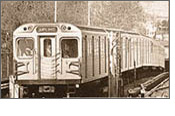History
3. Looking back
Toronto's first public transportation company was the Williams Omnibus Bus Line, which carried passengers in horse drawn stagecoaches along Yonge Street between the St. Lawrence Market and the Village of Yorkville for sixpence in 1849.
The city granted the first franchise for a street railway in 1861. In 1920, a Provincial Act created the Toronto Transportation Commission (TTC) and, in 1921, the Commission took over and amalgamated nine existing fare systems within the city limits. Between 1921 and 1953, the TTC added 35 new routes in the city and extended 20 more. It also operated 23 suburban routes on a service-for-cost basis.
The Great Depression and the Second World War both placed heavy burdens on the ability of municipalities to finance themselves. During most of the 1930s, municipal governments had to cope with general welfare costs and assistance to the unemployed. The war put an end to the depression and increased migration from rural to urban areas. After the war, municipalities faced the problem of extending services to accommodate the increased population.
Ironically, the one municipal service that prospered during the war years was public transit. The Union Station-to-Eglinton section of the Yonge Street subway - Toronto's first - opened in 1954 and was conceived and built with revenues gained during the war, when gas rationing limited the use of automobiles.

